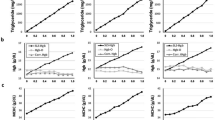Abstract
THE peroxidatic activity of the red blood pigment can be inhibited by cyanide in the case of methæmoglobin (HbIII), but not in the case of oxyhæmoglobin (HbII) (ref. 1). It seemed promising to use this difference for a differential staining procedure of HbII- and HbIII-containing red cells by first adding cyanide to the heparinized or citrated blood in question and by staining smears prepared from it by a peroxidase reaction.
This is a preview of subscription content, access via your institution
Access options
Subscribe to this journal
Receive 51 print issues and online access
$199.00 per year
only $3.90 per issue
Buy this article
- Purchase on Springer Link
- Instant access to full article PDF
Prices may be subject to local taxes which are calculated during checkout
Similar content being viewed by others
References
Betke, K., Biochem. Z., 321, 271 (1951).
Author information
Authors and Affiliations
Rights and permissions
About this article
Cite this article
KLEIHAUER, E., BETKE, K. Elution Procedure for the Demonstration of Methæmoglobin in Red Cells of Human Blood Smears. Nature 199, 1196–1197 (1963). https://doi.org/10.1038/1991196b0
Issue Date:
DOI: https://doi.org/10.1038/1991196b0
This article is cited by
-
A novel cytofluorometric assay for the detection and quantification of glucose-6-phosphate dehydrogenase deficiency
Scientific Reports (2012)
-
Diagnosis of red blood cell enzymopathies in infants, children and adolescents
The Indian Journal of Pediatrics (1987)
-
Die Glutathionreduktion in Erythrocyten von Gesunden und Enzymdefekttr�gern
Klinische Wochenschrift (1970)
-
Über zwei neue Fälle von hereditärer nichtsphärocytärer hämolytischer Anämie bei Glucose-6-Phosphat-Dehydrogenase-Defekt in einer norddeutschen Familie
Klinische Wochenschrift (1968)
-
Kongenitale nichtsphärozytäre hämolytische Anämien durch Mangel an Glucose-6-Phosphat-Dehydrogenase der Erythrozyten in einer japanischen Familie
Blut Zeitschrift für die Gesamte Blutforschung (1968)
Comments
By submitting a comment you agree to abide by our Terms and Community Guidelines. If you find something abusive or that does not comply with our terms or guidelines please flag it as inappropriate.



